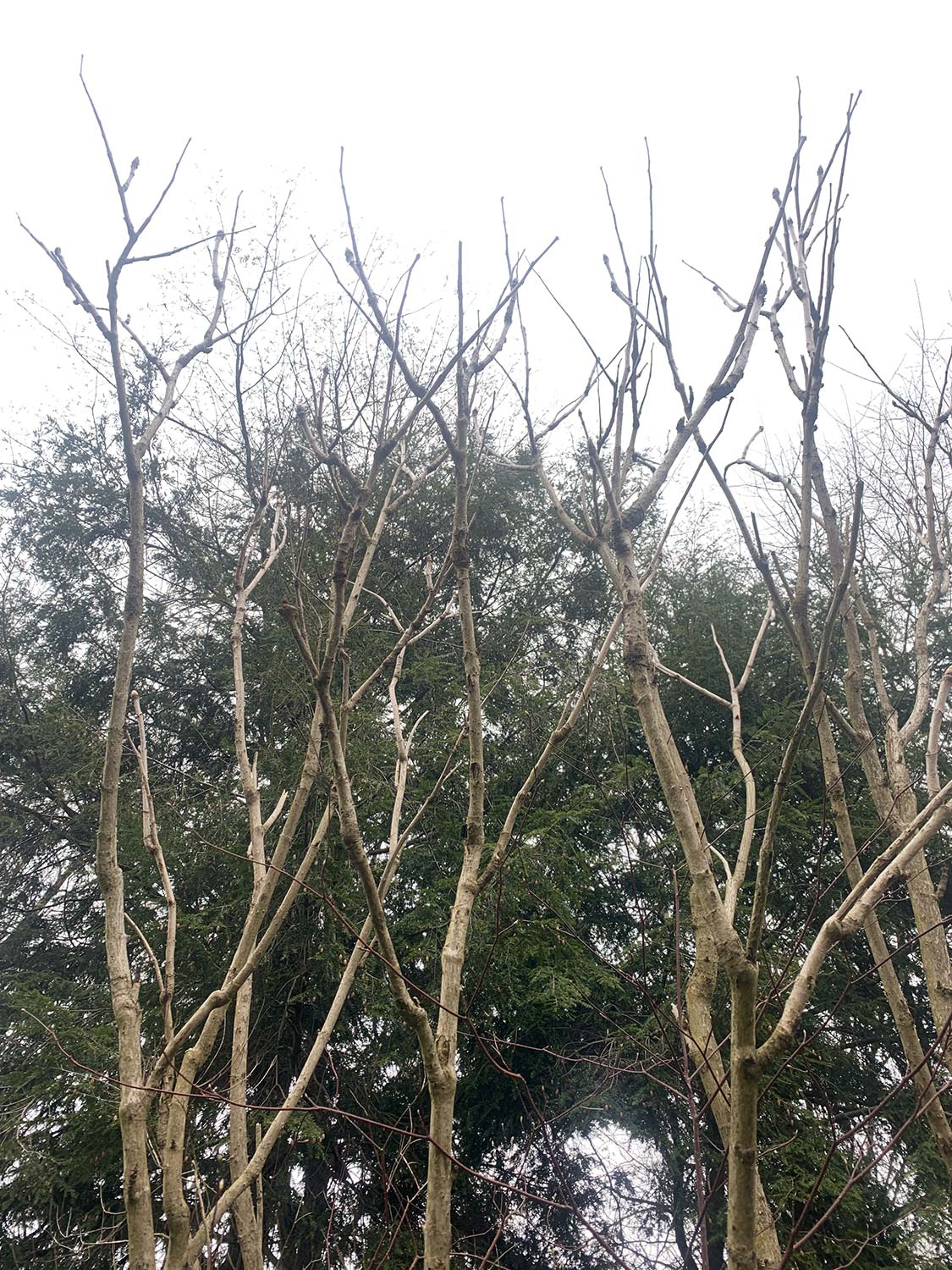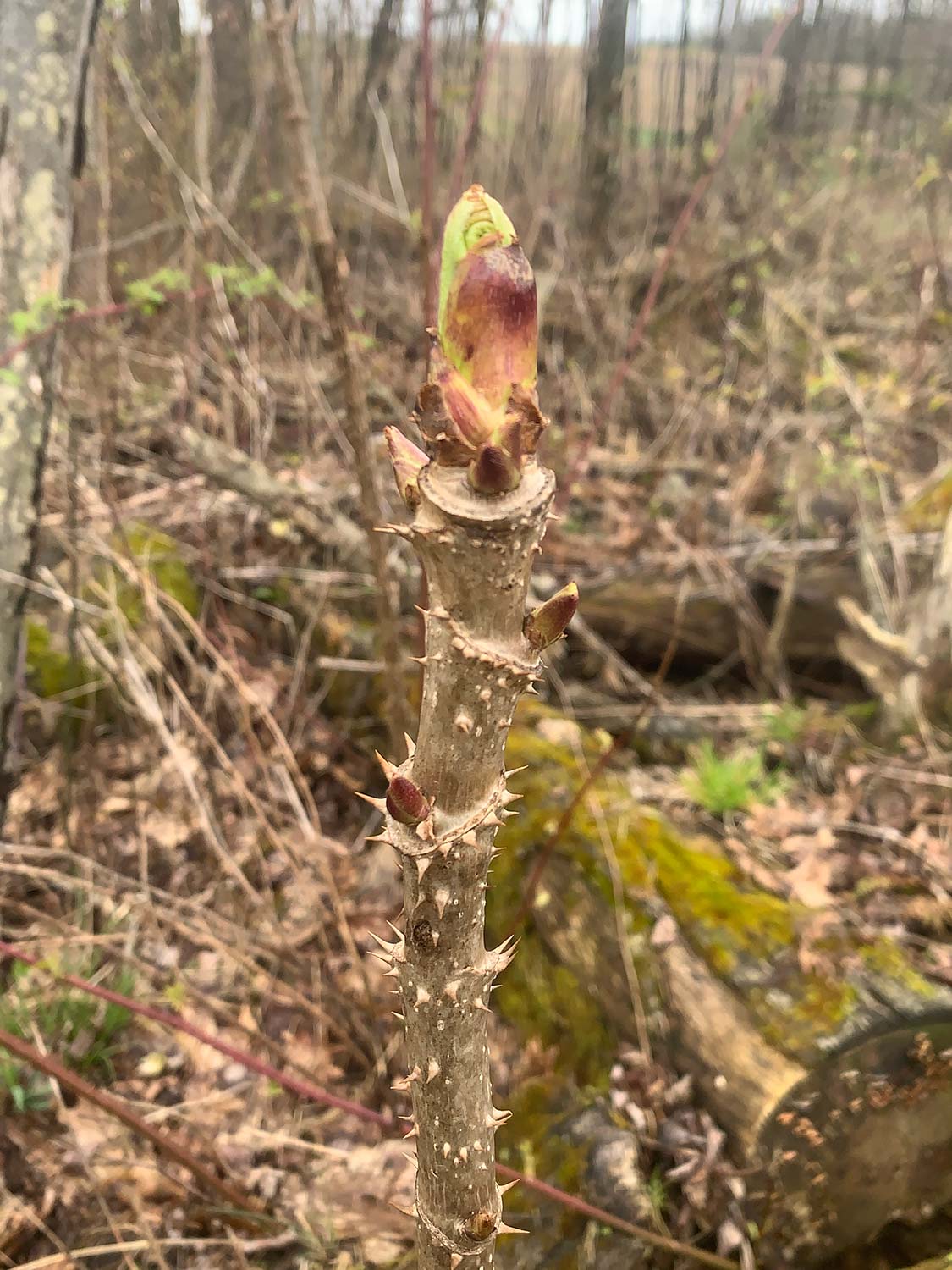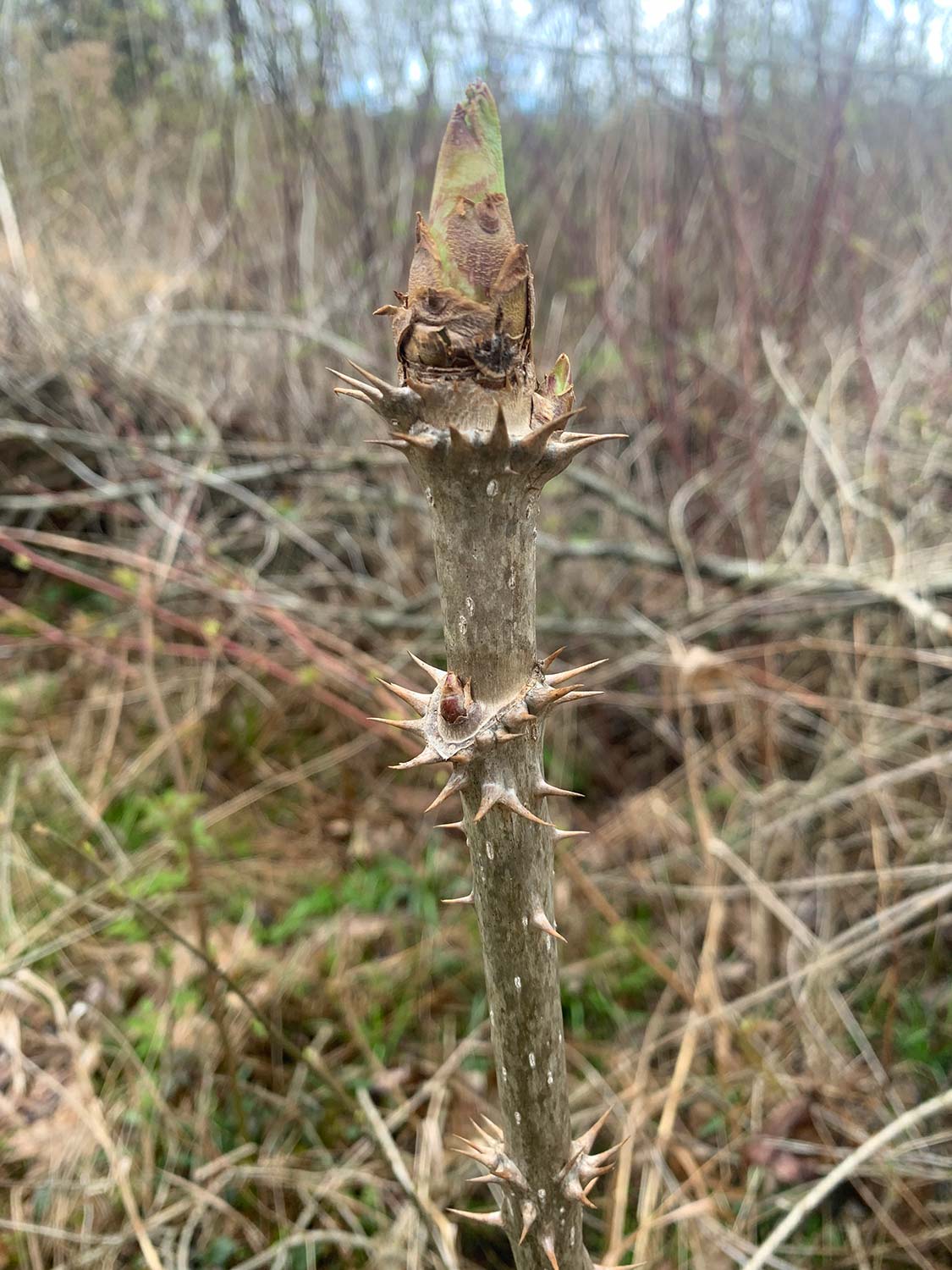
The Druid’s Garden Homestead is located on a 5-acre parcel of land in Western Pennsylvania that is currently regenerating from intense logging. Three years ago, just before we bought the property, the family who owned it logged about three of the five wooded acres. This has led to a host of possibilities where we can work on forest regeneration, observing the changes in this damaged place as it regrows, and certainly, opportunities for wildtending and creating food forests. As you walk through this regenerating landscape, one of the most striking understory trees is the Devil’s Walking Stick, Aralia spinosa. Looking like a very spiky and menacing walking stick (it has a name fitting of its visage), this tree is also known as Prickly Elder, Prickly Ash, Shotbush, Pigeon Tree, Angelica Tree, or Hercules club. These varied names really speak to the grotesque and yet wonderful nature of this plant and, I believe, give us some sense of its deeper meaning and uses.
This post is part of my Sacred Trees in the Americas series. In this series, I explore the magic, mythology, herbal, cultural, and divination uses, with the goal of eventually producing a larger work that explores many of our unique trees located on the US East Coast. Other trees in this series include Witch Hazel, Staghorn Sumac, Chestnut, Cherry, Juniper, Birch, Elder, Walnut, Eastern White Cedar, Hemlock, Sugar Maple, Hawthorn, Hickory, Beech, Ash, White Pine, Black Locust, and Oak. For information on how to work with trees spiritually, you can see my Druid Tree Working series including finding the face of the tree, communicating on the outer planes, communicating on the inner planes, establishing deep connections with trees, working with urban trees, tree energy, seasonal workings, and helping tree spirits pass.
This entry is going to differ somewhat from my previous entries in this series for a simple reason: there is almost no mythology, herbal, or magical knowledge about this tree. The giant stack of books and online databases of mythology that I regularly consult when developing this series have come up empty on this tree. Thus, I am going to rely much more on ecological knowledge, historical uses, and personal observations. Regardless of its lack of use traditionally, I think this tree is worthy of our attention and fills an important niche in the ecosystem of the US East Coast as a dominant pioneering tree with powerful energy.
Ecology
Aralia Spinosa, or the Devil’s Walking Stick, is in the ginseng family. It prefers part shade, moist soils, and can tolerate a range of soil conditions (fertile to poor, a wide range of PHs, and a wide range of soil types). As an aggressive pioneering species, it comes in after disruption in forest and field conditions, where it colonizes predominantly through rhizomes and sending out roots in different directions. The range of the Devil’s Walking Stick is quite widespread–it is native from Maine to Texas and grows up and down the entire eastern seaboard the whole way to Florida.

As the USDA Plant Database suggests, the Devil’s Walking Stick grows to a height of 35 feet, although as it is colonizing new areas, you can often find much smaller specimens. The leaves are compound and opposite, and every stalk literally is covered in spikes, even below the leaves and onto the leaf stems. The entire tree is covered in spikes, which do thin out as it gets larger. Some sources report that this tree can cause contact dermatitis if the roots or stalks are handled, but I have not found this to be the case (and in fact, have worked with the wood of it without any trouble!).
We actually have some very mature Devils Walking Sticks behind our garden, which are about 30-40 feet tall, and when they are in bloom in August, you can see thousands of butterfly moths, bees, and other insects all over the blooms. Their blooms look a lot like angelica with large umbles of small white flowers–the umbles can reach 12-24″ across and are massive on older trees. After the flowers go to seed, you can often see small birds feasting on the seeds along with deer and other wildlife. In the fall, the foliage turns dark yellow or purple and then pretty quickly drops from the leaves. The berry clusters remain a little longer and are early winter forage for birds.
One of my favorite quotes about this tree comes from the University of Florida State Extension office, “Devil’s walking stick…literally thrives on neglect.” It is also listed as “too aggressive for gardens”. Thus, if you want to plant it, the best thing to do is plant it and then leave it alone (and understand that planting one will lead to many as they colonize by roots and suckers!
Plants for the Future suggest that this tree may be very ancient and that the spines covering the stem and leaves are an earlier evolutionary development to dissuade larger herbivores (read dinosaurs, mammoths, etc) who might seek to eat it. Deer and elk do not browse on it. Given its very defensive and menacing appearance, that makes sense.
History of Human Use

One of the few recorded uses of Devil’s Walking Stick is that it was grown in gardens in the Victorian era as a “grotesque ornamental.” The Victorians were notorious for their love of the grotesque–those are things that are strange, hideous, or unpleasant while also being somehow mysterious, fantastical, or magnificent. In some ways, it was the juxtaposition of something that was fantastical aong with being unpleasant or strange that lead to the idea of grotesque. I actually think that this “grotesque” concept is an excellent fit for Devil’s Walking Stick, which is certainly a slightly weird, wonderful, and yet disturbing tree to come across!
Another recorded use of the Devil’s Walking Stick was with the Cherokees, as described by Hannah Dinkins in Plants of the Cherokees and their Uses. They were reported to harvest and roast the older roots and use them as an emetic (emetics are herbs that induce vomiting) or into a salve for healing old sores. Only the older roots were used this way, however, the young and green roots were considered poisonous. The other use is, which is clearly a more energetic healing approach, is to burn the wood, and then as the wood burned, the smoke was blown on a person who had paralysis to treat the paralysis.
In the New Garden Encyclopedia by L. D. Seymour, Seymor notes that herbalists have used the root of devil’s walking stick, which they dry and grind into powder, for treatment of rheumatism, asthma, and coughs. In all of my years of studying herbalism, I have not come across any teachings of this plant that were not in obscure references and there are very few listings (none in places like Wood’s Earthwise Herbal).
Plants for the Future notes that eating large amounts of the berries are poisonous. They suggest that the young leaves (with their slender spikes) must be gathered before the prickles harden and then can be finely chopped and used as a potherb). While this might be the case, even the young plants are pretty vicious and I’m not sure this plant has any desire to be eaten!

The wood itself that comes from the trees is extremely light, soft, and brittle. It has a lot of larger air holes, making it akin to something like young elder or staghorn sumac, but not as firm. Because of the nature of the wood, it does not have many human uses (although it will certainly start a decent campfire). I’ve worked with it a bit and have found that you can certainly make small things from it like wands, a walking stick, or staves, but I’m not sure you’d want it for any tough job (like a handle).
The Magic and Meanings of the Devil’s Walking Stick
I was unable to find any specific mythology or magic surrounding the Devil’s Walking Stick tree, despite its widespread growth here in the US. Based on the above information, we might consider at least three possible meanings for this tree:
Opportunistic and cunning. The Devils Walking Stick offers very opportunistic and cunning energy. It grows in areas that have been disrupted (like our logged forests) where it quickly colonizes and spreads, growing quickly and taking the opportunity provided.
Over-the-top Defenses. The Devil’s Walking Stick is one of the most defended trees here on the US East Coast. While its toxicity and thousands of thorns, nothing is going to get through to eat this tree. I think this tree obviously signals that defenses are needed, perhaps more than are necessary. I could see this tree being of use if you were feeling like you were being attacked or under duress.
Overcoming Adversity and Exorcism. The energy of this tree would be good for helping you overcome any kind of adversity that you face and exorcise unwanted things from your life (physical or metaphysical). This tree pulls no punches and stands in its power–and it will help you to do the same.

I will also note that if you are developing a local ogham, Devils Walking Sick could be a potentially very good replacement for the Ogham Straif (Blackthorn). Like Blackthorn, Devil’s Walking Stick is a pioneering species with a host of defenses and, frankly, the right kind of energy
I think that because this tree does not have a rich mythology or magical tradition, there’s a lot of opportunities to work with it, to experiment, and to see what comes. I would love to hear from you, my readers, about any insights, stories, or experiences you may have with the powerful Devil’s Walking Stick!
Additional Sources:
https://www.wildflower.org/plants/result.php?id_plant=arsp2
https://plants.usda.gov/core/profile?symbol=arsp2
http://www.missouribotanicalgarden.org/PlantFinder/PlantFinderDetails.aspx?kempercode=c294
https://davesgarden.com/guides/articles/view/1764
https://edis.ifas.ufl.edu/st080



Reblogged this on Paths I Walk.
Thanks for the reblog, Paula!
Reblogged this on Good Witches Homestead.
Thank you for the reblog!
Reblogged this on Blue Dragon Journal.
Interesting, Dana. I have not yet encountered this prickly plant, but have encountered a cousin of it called variously “Devil’s Club” or “Devil’s Walking Stick”, a prickly shrub with huge palmate leaves growing in the lush temperate forests of the Pacific Northwest. It is not a plant to play with or land in, either.
Yes, I think they are related! There’s actually a lot more magical lore on the Devil’s club (especially within the hoodoo community). I haven’t met one of those yet, but I would like to! Blessings!
The Devil’s Club is actually quite attractive as long as you don’t walk into it. It has handsome blooms, huge leaves, and bright red berries. Since the shrubs tend to grow beneath a high canopy or on steep shaded hillsides they can be an impediment for those travelers going cross-country! Climbers beware! Often grow with Vine Maple, an attractive native PNW small-leaved Maple.
That makes a ton of sense! I actually really like the look of the devils walking stick too! It can be really pretty, especially when it’s in bloom or when it has berries. But you certainly would never want to grab onto one!
Interesting piece Dana. I don’t remember ever seeing this plant. Checked the range maps and it looks like I am just past where it might be found even “non-natively”. (Montague MA)
https://en.wikipedia.org/wiki/Aralia_spinosa
https://gobotany.nativeplanttrust.org/species/aralia/spinosa/
Yes, it looks to be a little out of your range. With climate change, however, we are seeing ranges of plants that used to grow more southern move more northern, so perhaps it will show up in MA fairly soon! We are seeing that here–a lot of movement of southern species into Western PA as the seasons get warmer. Thanks for reading!
This is very interesting! I am very familiar with Devil’s Club (Oplopanax horridum) that grows here in the Pacific Northwest; I have both a wand and a walking stick made from Devil’s Club. However, there is a Devil’s Walking Stick (Aralia spinosa) growing in my back yard that someone had apparently planted–years before I moved there–as an ornamental. My landlord cut it down a couple of years ago during a remodeling of our back yard, but it still sends up shoots every year. I usually remove it, but may let it grow this spring now that I know more about it. Thank you for the information!
I’m not surprised that it shoots up new growth every year :-). I would give it a chance to grow! It’s a very powerful Ally and a really interesting tree. Let me know how it goes!
Here in eastern NC, I have a fair amount of Aralia spinosa across the road from me, which was logged a few years ago. How very interesting that it might be an extremely old species! It’s beautiful but definitely an odd tree. I like your suggestions for meanings.
Hi Anna,
I’m sure they will come up everywhere after logging! Thanks for sharing 🙂